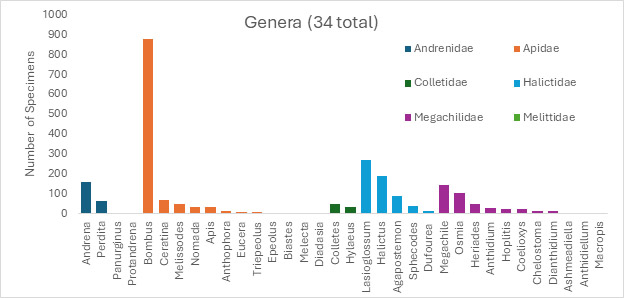On Your Marks, Get Your Net, Go!
- Native Bee Society of BC

- Jun 14
- 3 min read
By Mandy Brown
It’s not a race…or is it? Each season, bee enthusiasts unite, either in person or on iNaturalist, to sample and identify as many bees as they can. For some, the competition is fierce, bees are swiped from under noses, or out of others’ nets…no not really. For others it’s a relaxed, skipping through meadows sort of activity (that’s me). Either way, valuable information is collected and added to the small but growing database and ultimately our understanding of who our BC bees are and which flowers they forage on.
This database paints a picture of beautiful metallic bees, fuzzy bees, and tiny bees. Of bees feasting on perhaps just one type of native flower or many different types. Of bees that are out for a short window of time or long window, throughout the province or in a small part of it. This picture can inform conservation, highlight changes over the years, and inspire appreciation and wonder. We have begun painting our BC Bee picture and the outlines are all there, some broad strokes starting to show, and many many more details waiting to be filled in.
In 2024 the BC Native Bee Society started its very own Bee Atlas, a physical collection of bees with notes on when, where and on which flower they were caught. Our very own bee knower (ie. Taxonomist), Bonnie Zand, sat for hours upon hours, crouching over her microscope and 2434 precious bee specimens. So far she has identified half of those to species – quite the feat – and organized the remainder into family and genera.
Over 681 different sampling events, bees in all 6 families present in BC were collected (Apidae, Halictidae, Megachilidae, Andrenidae, Colletidae, and Melittidae). There were 34 of the 42 bee genera known to occur in BC collected from 200 different plant species! 150 different species have been identified so far from all years of data, with 110 species from 2024.


Important findings from this season include some rare bees:
Macropis nuda, the yellow loosestrife bee, which specializes on an oil producing plant (Lysimachia ciliata) and you can read all about it in this blog post.
Diadasia diminuta, the globemallow chimmey bee. Found foraging on Iliamna rivularis (Streambank Wild Hollyhock) in the Kootenay-Boundary region, this species is ranked as vulnerable in BC.
Chelostoma florisomne, the sleepy scissor bee. Our Bee Atlas was the first to record this newly introduced species, and we will have a blog post coming up where you can read all about it!
plus several other introduced species:
Osmia cornuta, the European mason bee
Anthidium oblongatum, the oblong woolcarder bee
Lasioglossum buccale, the long-faced sweat bee
Hyleaus punctatus, the punctate masked bee
and more!



As you can see from the map, we have a lot of extremely keen collectors on the island, the Okanagan, the Kootenays and a few further North, but there’s a whole wide province with a lot of un-sampled areas. Which is why we need you! If you’d like to put on your hiking shoes and join the fun, get trained to collect for the BC Bee Atlas through the OSU Master Mellitologist Program – https://extension.oregonstate.edu/master-melittologist
Of course, collecting the bees is only half the work! We welcome donations, sponsorships and partnerships to keep our BC Bee Atlas running and to reach the finish line of identifying all those amazing bees.
You can also donate to the bee atlas here.
Summer is here, the race has begun. Let’s put native bees on the podium!
If you have any questions, please email us at bcnativebees@gmail.com



Comments